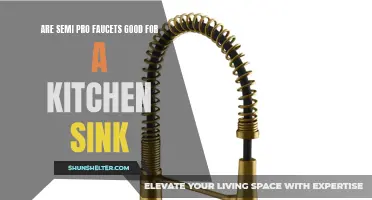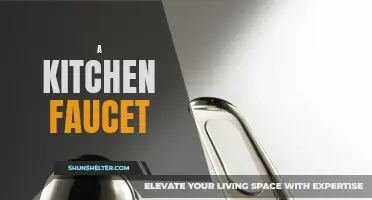
PVD kitchen faucets, also known as Physical Vapor Deposition faucets, offer a stylish and durable solution for your kitchen. Unlike traditional faucets that may tarnish or scratch over time, PVD faucets are coated with a thin layer of metal using a specialized vacuum coating process. This results in a finish that is resistant to wear and tear, making these faucets both beautiful and long-lasting. Whether you're looking to update your kitchen with a modern look or simply want a faucet that will stand the test of time, PVD kitchen faucets are a great choice.
| Characteristics | Values |
|---|---|
| Material | Brass, Stainless Steel, etc. |
| Finish | Chrome, Brushed Nickel, etc. |
| Type of Faucet | Single Handle, Double Handle, Pull-Down, etc. |
| Installation Method | Deck-Mounted, Wall-Mounted, etc. |
| Water Flow Rate | 1.8 GPM, 2.2 GPM, etc. |
| Spout Height | Various heights available |
| Spout Reach | Various reach options available |
| Number of Handles | One, Two, or Three Handles |
| Valve Type | Ceramic Disc, Compression, etc. |
| Spray Function | Spray, Stream, Dual Function, etc. |
| Hose Length | Varies depending on model |
| Warranty | Varies depending on manufacturer |
| Additional Features | Pull-Out Spray, Magnetic Docking, Touchless Technology, etc. |
What You'll Learn

Heading 1: Understanding PVD Kitchen Faucets

PVD stands for Physical Vapor Deposition and refers to a process that creates a thin, durable coating on the surface of materials, such as kitchen faucets. This coating enhances the faucet's resistance to wear, corrosion, and tarnishing. PVD coatings are commonly used in various industries, including aerospace, automotive, and now, the kitchen fixture industry.
The PVD coating process involves multiple steps to ensure a high-quality and consistent finish. First, the faucet's surface is cleaned thoroughly to remove any impurities, dirt, or oils. Once cleaned, the faucet is placed in a vacuum chamber where a small amount of metal, typically titanium or zirconium, is evaporated in a heated environment. This evaporated metal forms a vapor that condenses and bonds to the surface of the faucet, creating a strong and durable coating.
To ensure a uniform and attractive finish, the faucet may undergo additional steps, such as polishing and buffing, before and after the PVD coating is applied. This meticulous process ensures that the finish is not only durable but also visually appealing.
Investing in a PVD kitchen faucet comes with several advantages that make it a popular choice among homeowners. Here are some key benefits:
- Enhanced Durability: PVD coatings significantly improve the durability of kitchen faucets. The coating acts as a protective barrier against scratches, tarnishing, and corrosion caused by everyday use and exposure to water, chemicals, and cleaning agents. This means that your faucet will maintain its pristine appearance for years to come.
- Resistance to Abrasion: PVD coatings are highly resistant to abrasion, making them ideal for kitchen faucets that are subject to frequent use. Whether you're washing dishes or filling pots, the PVD coating will withstand the daily wear and tear, maintaining its original shine and finish.
- Low Maintenance: PVD-coated faucets are relatively easy to clean and maintain. Thanks to the durable coating, you can use gentle cleaning agents and a soft cloth to wipe away any dirt or grime. Unlike traditional chrome-plated faucets, PVD-coated faucets are less prone to water spots and fingerprints, making them easier to keep clean.
- Wide Range of Finishes: PVD coatings offer a wide range of finishes, allowing you to customize your kitchen faucet to match your decor style. Whether you prefer a sleek and modern chrome finish or a warm and rustic bronze finish, PVD coatings can achieve the desired look.
- Environmentally Friendly: PVD coatings are environmentally friendly compared to traditional chrome plating methods. PVD does not require the use of hazardous chemicals, making it a safer and more sustainable choice for your kitchen faucet.
In conclusion, PVD kitchen faucets offer superior durability, resistance to abrasion, low maintenance, a wide range of finishes, and environmental benefits. Understanding the PVD coating process and the advantages of PVD-coated faucets can help you make an informed decision when selecting a long-lasting and visually appealing kitchen fixture.
The Ultimate Guide to Removing a Stuck Kitchen Faucet Aerator
You may want to see also

Heading 2: PVD vs. other Faucet Finishes

When it comes to faucet finishes, chrome has long been a popular choice due to its shiny and polished appearance. However, PVD (Physical Vapor Deposition) finish has emerged as a strong competitor in recent years. PVD finish offers several advantages over chrome that make it a preferred choice for many homeowners.
For starters, PVD finish is known for its exceptional durability. While chrome finishes can be prone to scratches and wear over time, PVD finish is highly resistant to these issues. The PVD coating is bonded to the faucet surface at a molecular level, making it incredibly tough and resilient. This means that you can expect your faucet to retain its beautiful appearance for years to come, even with regular use.
In terms of aesthetics, PVD finish also has an edge over chrome. While chrome gives a shiny and mirrored finish, PVD finish offers a more sophisticated and elegant look. PVD finishes are available in a range of colors, including brushed gold, rose gold, and gunmetal, making it easier to find a finish that complements your bathroom or kitchen decor. This versatility sets PVD finish apart from chrome, which is typically only available in a bright silver color.
Stainless steel has long been favored for its durability and resistance to corrosion, making it a popular choice for faucets. However, PVD finish has gained recognition as an alternative that offers similar benefits while adding a touch of style.
One of the main advantages of PVD finish over stainless steel is its resistance to tarnishing and discoloration. Stainless steel faucets can develop water spots and stains over time, requiring regular maintenance to keep them looking their best. PVD finish, on the other hand, is highly resistant to these issues. Its molecular-level bonding ensures that the finish remains intact and impervious to discoloration, even with prolonged exposure to water and cleaning agents.
PVD finish also surpasses stainless steel in terms of available color options. While stainless steel faucets are typically limited to a silver hue, PVD finishes offer a wider range of colors, allowing you to choose a finish that suits your design preferences. Whether you prefer a modern black finish or a brushed bronze look, PVD can provide you with the versatility and aesthetic appeal you desire.
Brushed nickel has long been favored for its warm and subtle appearance, making it a popular option for faucets in both bathrooms and kitchens. However, PVD finish has emerged as a strong contender, offering similar benefits along with added durability.
One of the key advantages of PVD finish over brushed nickel is its resistance to scratching and wear. While brushed nickel finishes can be prone to showing scratches and signs of use, PVD finish is highly resistant to these issues. The PVD coating forms an incredibly durable and tough surface that can withstand the rigors of daily use, ensuring your faucet remains in pristine condition for years to come.
In terms of design options, PVD finish also provides more variety compared to brushed nickel. While brushed nickel faucets are typically available in a limited range of finishes, PVD finishes offer a broader spectrum of colors and finishes, allowing you to find a style that best suits your decor. Whether you prefer a sleek matte black or a classic brushed gold, PVD finish can provide the perfect touch of elegance and sophistication to your space.
In conclusion, while chrome, stainless steel, and brushed nickel have long been popular choices for faucet finishes, PVD finish has quickly gained recognition for its exceptional durability and versatility. Whether you are looking for a more resilient finish that can withstand scratches and wear, or you want a wider range of color options to match your design preferences, PVD finish is undoubtedly a top contender to consider. Its molecular-level bonding ensures that the finish remains intact and impervious to discoloration, even with regular use and exposure to water and cleaning agents. Explore the various PVD finishes available and elevate the look and functionality of your faucets today.
How to Achieve a Beautifully Whitewashed Kitchen Island
You may want to see also

Heading 3: Maintenance and Care for PVD Kitchen Faucets

Cleaning your PVD kitchen faucet is an essential part of its maintenance and care. By regularly cleaning your faucet, you can prevent the buildup of dirt, grime, and mineral deposits, ensuring its longevity and optimal performance.
To clean your PVD faucet, start by gently wiping down the surface with a soft cloth or sponge soaked in warm water. Avoid using abrasive cleaners or scrub brushes, as they can scratch the delicate PVD finish. For tough stains or residue, a mixture of mild dish soap and warm water can be used. Simply apply the soapy solution to a soft cloth and gently scrub the affected areas. Rinse the faucet thoroughly with clean water and dry it with a soft cloth to avoid water spots.
For stubborn calcium or lime deposits, a mixture of equal parts white vinegar and water can be used. Soak a cloth or sponge in the vinegar solution and apply it to the affected areas. Let the solution sit for a few minutes to loosen the deposits, then gently scrub and rinse the faucet. Be sure to dry the faucet completely after cleaning to prevent water spots and mineral buildup.
When cleaning your PVD faucet, it's important to avoid using harsh chemicals or abrasive cleaners. These can damage the PVD finish, causing it to peel, fade, or discolor over time. Instead, opt for mild dish soap, warm water, and white vinegar for routine cleaning.
Avoid using bleach, ammonia, or any cleaners containing acids or alkalis, as they can corrode the PVD finish. Additionally, avoid using abrasive scrub brushes or scouring pads, as they can scratch the surface of the faucet. Stick to soft cloths or sponges for gentle cleaning.
If you're unsure about a particular cleaner or product, always refer to the manufacturer's guidelines or consult with a professional. They can provide you with specific recommendations for cleaning and maintaining your PVD faucet.
Preventing scratches and damage to your PVD faucet is crucial for its long-term durability and aesthetics. Here are some preventative measures you can take to protect your faucet:
- Avoid using abrasive or harsh materials when cleaning the faucet. Opt for soft cloths or sponges instead.
- Be cautious when placing heavy objects or utensils near the faucet. Avoid banging or scratching the surface with pots, pans, or utensils.
- When using the faucet handle, avoid excessive force or twisting. Gently operate the handle to prevent stress on the PVD finish.
- Install a faucet aerator to reduce water pressure and minimize splashing. High water pressure can potentially damage the PVD finish over time.
- Consider using a sink mat or protective pad to prevent accidental scratches or dents caused by dropped dishes or utensils.
- Regularly inspect your faucet for any signs of wear or damage. If you notice any issues, such as peeling or discoloration, contact the manufacturer or a professional for assistance.
By following these maintenance and care tips, you can keep your PVD kitchen faucet looking and performing its best for years to come. Remember to clean it regularly, avoid harsh chemicals, and take preventative measures to prevent scratches and damage.
How to Easily Fix the Handle on Your Kitchen Faucet
You may want to see also

Heading 4: Choosing the Right PVD Kitchen Faucet

When it comes to choosing a PVD kitchen faucet, style and design are important factors to consider. PVD (Physical Vapor Deposition) finishes offer a variety of colors and textures that can complement any kitchen decor. Here are a few considerations to keep in mind when selecting the style and design of your PVD kitchen faucet:
- Coordinate with your kitchen theme: Consider the overall theme of your kitchen. If you have a modern, minimalist kitchen, a sleek and simple PVD kitchen faucet in a brushed stainless steel finish would be an excellent choice. On the other hand, if your kitchen has a more traditional or rustic feel, a PVD faucet with bronze or copper finish would complement the design beautifully.
- Choose a timeless design: Kitchen faucets are a long-term investment, so it's important to choose a design that won't quickly go out of style. Opting for a classic design with clean lines and a simple profile will ensure that your PVD kitchen faucet remains stylish for years to come.
- Consider the ergonomics: The design of your PVD kitchen faucet should also take into account your comfort and usability. Look for faucets with easy-to-use handles and a height that suits your needs. Pull-down or pull-out sprayers are also convenient for tasks like washing dishes or filling pots.
In addition to style and design, the functionality and features of a PVD kitchen faucet play an important role in its usability and convenience. Here are some key features to consider:
- Spout height and reach: The height and reach of the faucet spout will determine how effectively it can be used for various tasks. A high-arc spout provides ample clearance for filling large pots, while a longer reach allows for easy access to the entire sink.
- Sprayer options: Many PVD kitchen faucets come with built-in sprayers for added versatility. Look for faucets with pull-down or pull-out sprayers that offer different spray patterns. This will make it easier to clean dishes, rinse produce, and tackle various kitchen tasks.
- Temperature and flow control: Temperature and flow control mechanisms are essential for an efficient and comfortable kitchen faucet. Choose a PVD kitchen faucet with easy-to-use handles or levers that allow you to control the water temperature and flow with precision and ease.
When choosing a PVD kitchen faucet, it's important to consider your budget and the pricing options available. PVD faucets generally tend to be slightly more expensive than standard faucets, but they offer superior durability and long-lasting finishes. Here are a few factors to keep in mind regarding the budget and pricing of PVD faucets:
- Quality over price: While it may be tempting to opt for a cheaper PVD faucet, it's important to prioritize quality. Investing in a reputable brand and a well-constructed faucet will ensure that it stands the test of time.
- Warranty and customer support: Look for PVD faucets that come with a warranty to protect your investment. A warranty gives you peace of mind and ensures that you can get assistance or replacement parts if any issues arise.
- Consider the long-term benefits: Although PVD faucets may have a higher initial cost, their longevity and resistance to corrosion and tarnishing make them a worthwhile investment. In the long run, you'll save money on replacements and repairs, making the higher price tag worth it.
By considering the style and design, functionality and features, as well as your budget, you'll be able to choose the perfect PVD kitchen faucet for your needs. Take your time to do your research, compare different options, and consult with professionals if needed. With the right PVD kitchen faucet, you can enhance both the aesthetics and functionality of your kitchen for years to come.
Transform Your Kitchen with a Stunning Stone Island Installation
You may want to see also
Frequently asked questions
PVD stands for Physical Vapor Deposition, which is a high-tech coating process used to enhance the durability, appearance, and performance of kitchen faucets. This process involves vaporizing a metal into a gaseous form and then depositing it onto the surface of the faucet, creating a thin, durable coating that is resistant to tarnishing, scratching, and peeling.
Yes, PVD kitchen faucets are generally considered to be better than traditional faucets. The PVD coating significantly increases the durability and lifespan of the faucet, making it less likely to tarnish, scratch, or fade over time. Additionally, PVD coatings can be applied in a wide range of colors and finishes, allowing for greater customization and design options.
To clean and maintain a PVD kitchen faucet, it is best to avoid abrasive cleaners, harsh chemicals, and abrasive scrubbing pads, as these can damage the PVD coating. Instead, use a mild soap or detergent and a soft cloth or sponge to gently clean the surface of the faucet. Be sure to rinse thoroughly and dry the faucet after cleaning to prevent water spots.
While the PVD coating on a kitchen faucet is highly durable, it is not indestructible. Over time, the coating may show signs of wear or damage, such as scratches or peeling. In some cases, it may be possible to have the PVD coating repaired or re-applied by a professional. However, this can be a costly and time-consuming process, so it is important to take proper care of the faucet to minimize the need for repairs.
Yes, PVD kitchen faucets are generally more expensive than traditional faucets. The high-tech coating process and increased durability of PVD faucets contribute to their higher price point. However, many homeowners consider the investment in a PVD kitchen faucet to be worthwhile, as they offer superior performance and longevity compared to traditional faucets.







